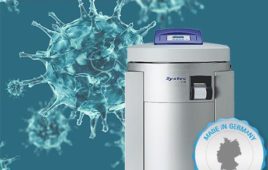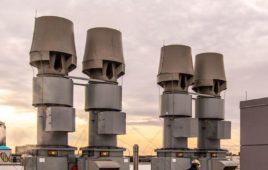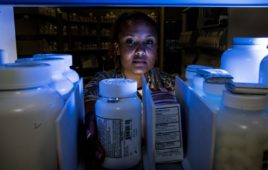The science-based standards of the U.S. Pharmacopeia (USP) are used and relied upon worldwide. They regulate and set quality control standards for the thousands of drugs produced annually by the multi-billion-dollar pharmaceutical industry.
The USP requires pharmaceutical and biopharmaceutical manufacturers making injections and infusions to follow their stringent rules regarding the quantity of particles present in the final drug product. Further, it recommends that liquid particle testing is carried out in a controlled environment to further reduce the risk of contamination during testing. Measuring the amount of contaminating particles is important for patient safety as particles in injectable and infusion drug therapies can be harmful. For example, if there are too many particles present then these may occlude the fine capillaries of the blood system, such as those in the brain. It is therefore important to be able to more accurately identify and characterize sub-populations of particulate matter.
With this in mind, the USP has recently introduced a new regulation specifically regarding the more costly protein formulations that are now being developed. This increasing focus on biological drugs is driven in part by the need to tackle global killers such as heart disease and diabetes and the trend towards more personalized medicine.
Until recently, there was only one chapter in the USP regulating this requirement — Particulate Matter in Injections <788>. However, this was not considered specific enough to cover the more complex, protein therapies currently being developed. In addition, these drugs are being made in far smaller volumes, leading to cost implications for manufacturers trying to follow USP <788>. Last year, the USP introduced a new chapter to modify the existing <788> testing requirements by light obscuration to address the greater sensitivities of protein products. The new chapter, Subvisible Particulate Matter in Therapeutic Protein Injections <787>, also provides an opportunity to safely reduce their escalating compliance costs while still ensuring formulation quality.
Cleanroom requirements for liquid particle counting
Contaminating particles in injectable/infusion drug therapies may be microbiological, causing infection in the patient. In addition, the particles may cause an allergic reaction, or in extreme cases anaphylactic shock. For these reasons, Good Manufacturing Practice (GMP) documents require injections and infusions to be manufactured in controlled environments to limit the possibility of contamination of the product by airborne particulates.
The same risk of contamination by airborne particles exists while carrying out the tests for particulate levels in the final product. For this reason, both USP <788> and the new USP <787> recommend that the liquid particle testing is carried out in a controlled environment to reduce the risk of contamination during sample testing and prevent “false positives.” For example, if particles fall into the drug product while the testing is being carried out, the test may not pass, even though the drug product may have been manufactured safely in the first place.
Similar to the sterility test, failure of one single vial from a batch indicates that the whole batch cannot be released, simply because the test is destructive and the contaminating event may be random, therefore a pass result when testing a second vial does not rule out that other vials in the batch may also be contaminated. For this reason it is very important to protect the sample during testing to reduce the risk of a contamination event during the testing itself. Without this, it would be impossible to prove that a vial was contaminated during the test but would have passed the test otherwise.
To determine counting accuracy known suspensions of Ezy Cal from Thermo Scientific were used by Beckman Coulter at the specific volumes noted in Table 1.
Key features of new USP <787>
The new regulation accepts that the presence of insoluble protein particles is an intrinsic part of protein-based therapies and labels these naturally occurring particles as “inherent” particles. It differentiates between these inherent protein particles and those “contaminating” particles that should not be present. It goes further and sub divides the latter into:
• Extrinsic particles: those that are added to or fall into the drug product from an external source, such as the air.
• Intrinsic particles: those already present in the drug container before it is filled with the drug product. This may come from ineffective cleaning processes or as a result of potential aggregation of the drug compound itself over time.
Both USP chapters <788> and <787> require the manufacturer to test for particles at ≥10 micron and ≥25 micron in size. Typically the inherent protein particles are in the sub-micron, nanometer size range and are not, therefore, detected by the tests. However, a common feature of protein-based therapies is the tendency of the proteins to group together, or aggregate, over time. Because of this, protein aggregations are likely to form large enough particles to have an impact on the pass or fail result of the USP <787> or <788> test. Protein aggregation is also undesirable from a drug efficacy point of view as aggregation causes the therapeutic part of the protein to become occluded, making it less effective. For the patient, this means that the normal dosage may no longer work and their condition would therefore deteriorate.
Table 1: Gravimetric Data — Volumetric Weight
| 1.0 mL | 0.5 mL | 0.3 mL | 0.2 mL | 0.1 mL | |
| Draw 1 | 0.99970 | 0.50000 | 0.30010 | 0.20500 | 0.11080 |
| Draw 2 | 0.99740 | 0.49870 | 0.30000 | 0.20060 | 0.10180 |
| Draw 3 | 0.99740 | 0.49890 | 0.29960 | 0.20120 | 0.10010 |
| Draw 4 | 0.99860 | 0.49860 | 0.29950 | 0.20000 | 0.10010 |
| Draw 5 | 0.99740 | 0.49900 | 0.30000 | 0.20440 | 0.10030 |
| Average | 0.99810 | 0.49904 | 0.29984 | 0.20224 | 0.10262 |
| S.D. | 0.00093 | 0.00050 | 0.00024 | 0.00205 | 0.00414 |
| Total volume (mL) | 4.99050 | 2.49520 | 1.49920 | 1.01120 | 0.51310 |
| Volume accuracy | 0.09% | 0.10% | 0.08% | 1.02% | 4.03% |
As well as accepting that therapeutic protein products may contain inherent particles, USP <787> also takes into account that the volume of these modern injections will normally be minute, typically smaller than those of a small molecule drug product. Under the requirements laid down in USP <788>, which specifically references 25 mL of pooled sample volume, this presents a necessary, but unwelcome, cost implication. As safety testing has to be carried out on every batch, applying USP <788> to protein-based therapies would involve testing large quantities of very expensive product.
Instrumentation changes
To address this, USP <787> now allows the test to be carried out on sample volumes of between 0.2 mL and 5 mL, provided the tester generates a body of evidence to demonstrate that the sample tested is a good statistical representation of the whole manufactured batch. Total particle content is limited to 6,000 particles and particle-size thresholds for both USPs set the same limits: ≥10 μm and 600 particles ≥ 25 μm for all dosage forms. However, the new USP <787> regulation recommends that populations below the 10 μm threshold should be regularly monitored in order to better characterize the stability of the final drug formulation, in particular to look for protein aggregations.
USP <787> encourages the manufacturer of protein-based therapies not only to perform the particle test using a light obscuration particle counter but also to carry out orthogonal testing using different analysis techniques so that the manufacturer can better characterize their drug product and its stability over time, particularly the aggregating properties of the proteins.
 The introduction of USP <787> now provides the option of testing samples down to 0.2 mL which requires an instrument that can accurately measure, dispense, and count at these small volumes. Tests carried out for the HIAC 9703 report >90 percent sample accuracy on volumes for test volumes down to 0.2 mL.
The introduction of USP <787> now provides the option of testing samples down to 0.2 mL which requires an instrument that can accurately measure, dispense, and count at these small volumes. Tests carried out for the HIAC 9703 report >90 percent sample accuracy on volumes for test volumes down to 0.2 mL.
Instrumentation manufacturers have to play their part in ensuring that the liquid particle counting systems are able to handle the smallest samples, so that full compliance testing can be achieved from just 1 mL of product. The USP <787> test should also be incorporated into the instrument’s software. Generating accurate data with small sample volumes can be error-prone, especially due to run to run variances that can skew the data. Small volume testing requires an instrument that can precisely deliver selected volumes while at the same time minimize count errors.
Manufacturers like Beckman Coulter Life Sciences already have specific liquid counting systems (the HIAC 9703) with a sampling mechanism that has been adapted to accommodate the small, uniquely shaped vials that are typical for protein-based therapeutics to ensure no expensive sample is wasted, as well as the tiny sample volume (0.2 mL to 5 mL) involved.
The way ahead for compliance testing
Both USP <788> and the new <787> recommend that the liquid particle tests are carried out in a controlled environment. For the first time, USP <787> offers manufacturers of protein-based therapies an alternative to USP <788> testing. As with all quality testing, it is the user’s responsibility to build evidence to justify that the test procedure adopted is compliant and provides a statistically representative picture of the batch quality as a whole. While the test pass/fail criteria is the same for both USP <787> and <788>, the new regulation enables manufacturers of therapeutic proteins to reduce the number of doses needed to demonstrate compliance and, therefore, achieve significant cost savings.
Tony Harrison is a global compliance expert on cleanroom policy and is actively involved in ISO standards development. He is currently tasked with revising ISO 14644-1 and -2 and involved on the revision of ISO 14698-1 and -2 for the classification of the cleanroom environment by microbiological cleanliness. He is in the Beckman Coulter Particle Business Unit in Grants Pass, Ore., and can be reached at [email protected]. www.particle.com
This article appeared in the November/December 2015 issue of Controlled Environments.



